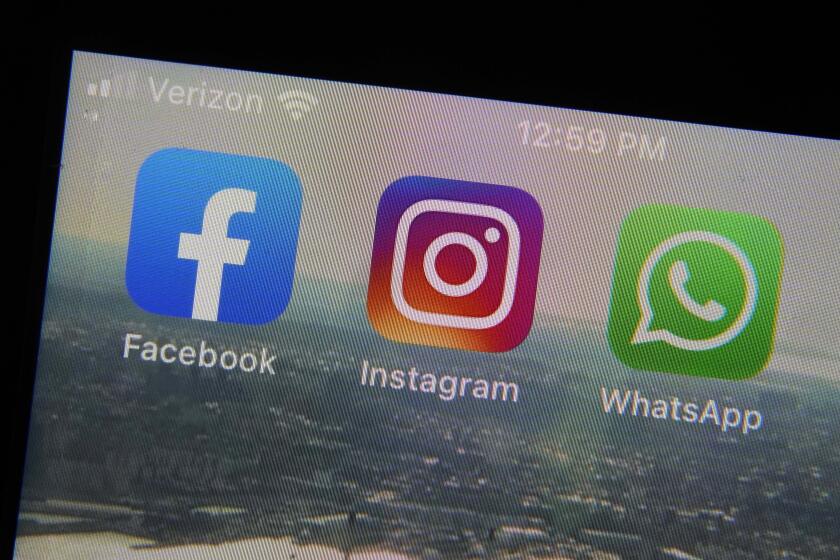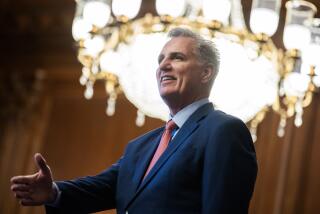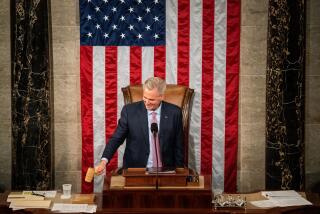Drama of McCarthy’s election may open House to more cameras

- Share via
NEW YORK — The difference between a government-controlled camera that followed a climactic moment in Rep. Kevin McCarthy’s election as House speaker and one operated by a C-SPAN journalist was like a fuzzy black-and-white picture contrasted with sparkling, clear color.
In one, McCarthy (R-Bakersfield) strides up an aisle in the House chamber and disappears from view. A few people in the front turn to see where he’s going. After a minute, and some audible gasps, everyone stands to watch what the camera doesn’t show.
C-SPAN captured the scene, including the exasperated McCarthy’s tense, finger-pointing conversation with Rep. Matt Gaetz (R-Fla.) and a GOP colleague being held back from lunging at Gaetz.
Some in Congress and C-SPAN are seizing on that moment to ask that the House floor be more fully open to cameras, in the interest of transparency. There has been tangible movement in that direction.
McCarthy, as House speaker, has the final word. His office has signaled that changes are being considered. Already, government cameras have broadened their views.
New bills would hold social media companies liable for promoting the sale of fentanyl to youth and facilitating commercial sexual exploitation of minors.
“I’m guardedly optimistic that the speaker would consider independent media coverage, if not permanently, at least on request,” said Ben O’Connell, C-SPAN’s director of editorial operations. “We had a lot of positive feedback from both sides of the aisle.”
There’s been little change in how the public has seen House sessions since cameras were first brought in almost 44 years ago, according to Susan Swain, C-SPAN’s co-CEO. For the most part, the podium and lawmakers who come to the front to speak are shown, but little else is. There are exceptions when other cameras are allowed, such as when a joint session of Congress is convened for the State of the Union.
The quirk that increased visibility that week in January was that at the time, there was technically no speaker. Outgoing Speaker Nancy Pelosi (D-San Francisco) consented to three C-SPAN cameras, O’Connell said.
“We want to make it as accessible as possible, and I think cameras do that,” said Rep. Mark Pocan (D-Wis.), who has 25 co-sponsors for a resolution supporting C-SPAN’s bid.
Beyond the McCarthy drama, cameras offered insights such as a conversation between political polar opposites Reps. Alexandria Ocasio-Cortez (D-N.Y.) and Paul Gosar (R-Ariz.).
All of Pocan’s co-sponsors on the resolution are Democrats, which give them little sway with McCarthy. But there has been some GOP support for the concept, including from Gaetz.
Rep. Chip Roy (R-Texas) was quoted by CNN as saying, “What the American people were able to see unfold on the floor was a good thing for our democracy and our republic.”
Given how the speaker’s vote played out in public, it wouldn’t surprise Pocan if McCarthy had little interest in proceedings that are more closely watched. But that hasn’t been the case.
McCarthy’s office didn’t necessarily mind how things looked during the vote and is open to greater access on certain occasions.
“We are exploring a number of options to open up the People’s House to ensure a more transparent and accessible Congress for the American people,” said Mark Bednar, a McCarthy spokesman.
The Senate has similar rules, but the House has received more attention because of the McCarthy vote.
Without fanfare, the government-controlled cameras have been offering novel views in recent weeks, observers said. There are eight cameras installed; four years ago, there were six.
What’s uncertain is whether C-SPAN will get what it prefers: its own cameras, installed in the gallery overlooking the House floor, controlled robotically by journalists and available by pool to all news organizations.
McCarthy’s office is likely to move with caution, said Brendan Buck, who worked for former Speakers John Boehner (R-Ohio) and Paul Ryan (R-Wis.) and is now a partner at the communications firm Seven Letter.
“Once you give something, it’s hard to take it back,” he said. “They have to make sure they are comfortable giving the access, knowing that it may be forever.”
Buck said he believes that some rank-and-file members of Congress would be more resistant than leadership. With Washington increasingly segregated by party, the House floor is one of the few places members have to get to know colleagues with whom they might not normally spend time, he said.
“They don’t want every conversation they have to have eyes and ears on it,” Buck said. That may not be a good reason to restrict cameras, but it may actually serve democracy, he added.
Further, the presence of more cameras might promote performing rather than legislating, a point Pocan conceded.
“But, honestly, people who are going to cause disruption are going to do it regardless,” he said. Pocan doesn’t want cameras kept away for the wrong reasons, like the risk of a representative getting caught dozing on the job.
Every time a new speaker has been elected in the 22 years that O’Connell has been at C-SPAN, the company’s top executive dutifully writes to request access to the chamber by journalists with video cameras, he said.
This year, he said, “I didn’t think we were going to do anything, because it felt like we were shouting at a wall.”
Yet the speaker’s vote, of which C-SPAN’s video was used widely by other television networks and on social media, led Swain to try again.
The Radio and Television Correspondents Assn., which represents broadcast outlets that cover Congress, supports C-SPAN’s request. The group’s chairman, Jared Halpern, said he appreciates the willingness of McCarthy’s office to explore alternatives.
If changes are made, they would be tied directly to the night McCarthy was elected.
“It was a perfect crystallization of the argument for allowing independent media in the chamber on a more regular basis,” O’Connell said.
More to Read
Sign up for Essential California
The most important California stories and recommendations in your inbox every morning.
You may occasionally receive promotional content from the Los Angeles Times.














